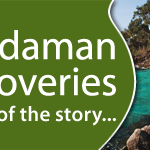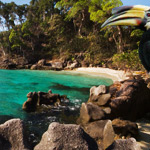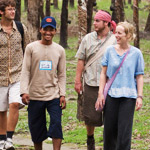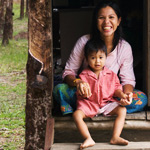Andaman Discoveries Blog
Monday, April 20, 2009
Keeping It Real
 You may not know it, but you are part of a global movement. We are a group of international citizens who seek to make a difference wherever we are in the world. The way we travel has many names:
You may not know it, but you are part of a global movement. We are a group of international citizens who seek to make a difference wherever we are in the world. The way we travel has many names:- Ecotourism,
- Responsible travel,
- Sustainable travel,
- Community-based tourism
We hope the stories that follow will further detail what sets Andaman Discoveries apart from the crowd. We thank you for your continued readership and support of our efforts.
Genuine responsible tourism operators have a duty to the communities they serve. Long before marketing, this requires understanding local priorities and sense of place, and then using this information to develop an appropriate program. It doesn’t happen overnight. All too often tour operators -- even ones with good intentions -- raise hopes and artificially inflate local economies without understanding the consequences of their actions. The results can be disastrous, and there are numerous examples of villages that have suffered from loss of traditional livelihoods and money-driven conflict.
That’s why Andaman Discoveries is committed to supporting consistent progress in an imperfect world. Often this means working with opposing viewpoints, even within a community. After all, communities do not always speak with one voice, and by maintaining balanced relationships, we are able to work with all parties. The mutual respect we have earned with our community partners is a testament to the effectiveness of our long-term projects and inclusive viewpoint.
Fragile Earth
Getting back to sustainable agriculture
 Monoculture farming is transforming the landscape of rural Thailand. As part of our growing community tourism network, a number of our village partners recently visited northern Thailand, where they learned about the all-too-common shortcomings of monoculture.
Monoculture farming is transforming the landscape of rural Thailand. As part of our growing community tourism network, a number of our village partners recently visited northern Thailand, where they learned about the all-too-common shortcomings of monoculture.The group heard a poignant story from Sud, a small-scale plantation-owner who used to farm cassava root (most famously used in tapioca). For years he struggled to make a livable wage, strained by the high costs of industrial fertilizer and seeds required to sustain this nutrient-intensive crop. After a drought wiped out his crop, he lost everything. Fortunately, training from a local NGO helped redirect his agricultural skills, and he now manages a local community organic farming group. Sud and his group demonstrated how to use bio-fertilizer and employ various organic farming techniques.
The week-long study trip was packed with informative seminars about how to manage sustainable livelihoods and healthy ecosystems. Participants learned about coastal ecosystems, eco-tourism, organic farming, natural resource management, community welfare, and management of foundations and government. The trip provided an opportunity for participants to see models from other communities in the Kuraburi area all the way up to sites in northern Thailand.
Director Tui Chomphrusi represented Andaman Discoveries at the study trip. She remembers a particularly moving and universally-resonant remark from Anan Duangkaewrueng, a former government official turned activist in Chiang Mai: “The answer is not from government, the answer is from community.”
Labels: conservation, monoculture farming, Thailand
Erik’s Journal
Skills for the real world at Phuket Special School
 Since 1993, Phuket Special School has provided a safe and educational haven for disabled, autistic, and deaf children from the ages 6 to 21. Every year, the school hosts a scout camp to develop important life skills and have fun outdoors. We sent Erik Rogers, our creative guru, to join in the festivities:
Since 1993, Phuket Special School has provided a safe and educational haven for disabled, autistic, and deaf children from the ages 6 to 21. Every year, the school hosts a scout camp to develop important life skills and have fun outdoors. We sent Erik Rogers, our creative guru, to join in the festivities:“It was one of the most enjoyable experiences of my several years in Thailand. I was imdeiately welcomed by the children, who nicknamed me P’ Nung, which translates to ‘older brother number one.’
“The first morning we assembled large tents, dug holes for organic waste, and made dish-drying racks out of bamboo. After lunch, we broke into teams for sports, song, and dance. The evening was equally active, with night-time rope-walking challenges and obstacles courses that would give an army cadet pause. The laughter and song carried on until almost 10 pm.
“I continue to be amazed and inspired by the extraordinary resilience of these young people in the face of very difficult circumstances.”
Labels: disabled children, Phuket, Thailand, volunteering
Legends of the Sea Nomads
Voluntourists treated to stories of Moken culture
 Claudine and Gill (UK) were among Andaman Discoveries’ first voluntourists in Tung Dap village, each enticed by our March special tour offer. Their two-day homestay allowed them participate in and assess several newly-developed cultural activities (and with her nine years’ of experience managing international development projects, Claudine’s feedback was invaluable!). However, the highlight of the trip was homestay host P’ Noi’s evening tales of the seafaring lives the Moken “sea gypsies” -- who comprise about half the village’s population -- were still living a generation ago.
Claudine and Gill (UK) were among Andaman Discoveries’ first voluntourists in Tung Dap village, each enticed by our March special tour offer. Their two-day homestay allowed them participate in and assess several newly-developed cultural activities (and with her nine years’ of experience managing international development projects, Claudine’s feedback was invaluable!). However, the highlight of the trip was homestay host P’ Noi’s evening tales of the seafaring lives the Moken “sea gypsies” -- who comprise about half the village’s population -- were still living a generation ago.“Perhaps the most enjoyable and memorable part of our stay was listening to the stories of our homestay host, P' Noi. After we had eaten we would sit on the floor in P' Noi’s beautiful wooden house listening to stories from her Moken childhood. P' Noi spent the majority of her childhood aboard a Kabang -- a traditional wooden boat which the Moken use as a home, fishing boat, and for transportation. The Moken used to spend months at time on the ocean, t raveling around the Andaman Sea in search of the fish which made up the majority of their diet.”
You can read Claudine's complete story on our blog. You can learn more about this village on our website, or contact us for details.
Labels: Andaman, homestay, Moken, Thailand, Tung Dap
Kids on Vacation
Family Snapshots from Ban Talae Nok
 The Tausend family (pictured) shared a special reflection about their visit with their two children, ages four and eight:
The Tausend family (pictured) shared a special reflection about their visit with their two children, ages four and eight: “I will never forget the palm weaving activity. We walked up to this older woman's home. She was weaving palms on her front porch and invited us to join her. I was a bit worried about our four-year-old because I didn't know if this was something he would be able to do. The grandma was so patient and helped him the whole time -- with every step. She didn't speak a word of English, but her smile and nods of approval made our son’s face light up several times. What an incredible gift to us as a family, but especially to our little one!”
The Hoyt family had a very different but equally special moment. Their son celebrated his 13th birthday with community members and a delicious cake provided by Andaman Discoveries, and he won’t likely forget the experience of having “Happy Birthday” sung to him by both his parents and his Thai host family! At the end of their homestay the family said, “The people are very gracious, the food is incredible and the children are as friendly as can be. While here, you won’t be looking at Thailand, you will be in Thailand.”
Labels: eco tour, family, homestay, Thailand
Finding “True Thailand”
 A Journey to Muang Kluang Village
A Journey to Muang Kluang VillageTwo guests participated in community tours in Muang Kluang in March. For Ruth (Ireland), it was one of the highlights of her Thailand holiday. “We all sat and ate some great food. For me this was the most interesting part of the trip because I felt like I was in true Thailand,” she said. In addition, Ruth enjoyed activities including traditional basket weaving, mangrove tree planting, and a scenic nature hike.
The Muang Klaung homestay program will benefit the villagers through revenue generation that will go towards skills development and youth education. You can learn more about this village on our website, or contact us for details.
Labels: homestay, mangrove planting, Muang Kluang, nature hike, Thailand, traditional basket weaving
Southern Thailand Orphanage
French couple pilot new long-term volunteer opportunity
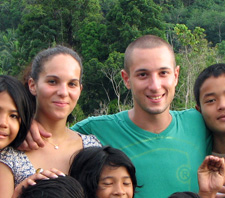 Jeremy and Audrey (France) wanted to spend time with local people and contribute their talents to a worthwhile cause. They found that opportunity through Andaman Discoveries’ newest long-term volunteering program at a southern Thailand orphanage.
Jeremy and Audrey (France) wanted to spend time with local people and contribute their talents to a worthwhile cause. They found that opportunity through Andaman Discoveries’ newest long-term volunteering program at a southern Thailand orphanage.During their nine days at the orphanage, Jeremy and Audrey taught the children fun activities like juggling, and also assisted them with gardening, handicrafts, cooking, drawing, and various construction projects. They discovered that even simple acts like smiling and eating with the children provided companionship and support. “The eldest children are really independent, so most of the time we were with the younger ones. They like drawing, singing and listening to us read story books. The children were always ready and happy to do things with us.”
The couple concluded that “it was a wonderful experience. Thank you to Andaman Discoveries for introducing us to the orphanage. We encourage everybody to do the same.” You can learn more about this new program on our website, or contact us for details.
Labels: orphanage, Thailand, tsunami, volunteer, volunteering
Thursday, April 9, 2009
Hongs by Starlight in Phang Nga Bay
 Experiences in Thailand
Experiences in ThailandBy Leslie Welshimer
Two months had passed since I’d been in Phuket when I arrived in Thailand. I’d heard of John Gray’s Sea Canoe the last time I was in Phuket, but thought it may be too pricy. Instead, I signed up for a less-expensive tour from another provider that left me feeling unsatisfied.
 |
| Kayaks allow guests to see islands up close, paddling along the stunning edges |
When talking with co-workers about possible tours on the water in the Phuket area, they said, “If you’re going to do something like a kayak/boat trip, John Gray is the one to go through.”
John Gray has a reputation for being one of the original pioneers of sea kayaking tours with an environmental conscience. He started sea kayaking tours in Hawaii in 1983, and moved to Phuket six years later. There have been many who’ve tried to imitate, but there is only one John Gray Sea Canoe.
I was won over by reading, review after review, on sites like Trip Advisor that said, “If you do one thing in Thailand, do this.”
The John Gray Web site convinced me in stating, “What's important is Value. Your vacation time is precious, and you want to pack it with top-notch experiences. The value of a mediocre trip is a lost vacation day. So we provide unsurpassed value at the best possible price.”
 |
| Tours inside caves offer a unique viewpoint of awe-inspiring formations. |
Fourteen other guests and I boarded a twin-engine boat. As we made the journey toward Phanak Island, we were served a tasty lunch of fresh fruit, spring rolls, noodles and salad.
The guides were exceptional. While eating, they gave us a friendly welcome and a brief presentation about what to anticipate for the day.
 |
| Pink (guide extraordinaire), Brendan (guest from Australia) and Leslie explore a lagoon in Phanak Island. |
The scenery along the way was breathtaking. Large islands loomed around us. Phuket seemed a distant memory.
There was one other solo traveler on the trip. Brendan, from Australia, and I were paired for the day. Our guide, Pink, had a calm, warm personality. His English was perfection, but more importantly he was an expert with a kayak.
I thought I’d be disappointed that the guides do the paddling, but I enjoyed being able to relax and take in all the scenery. We were led through caves that seemed to magically appear along the face of the islands. The caves were completely dark. We were given flashlights to see bats and impressive formations.
The caves led to secluded lagoons bursting with light, reminding me of the movie, “The beach.” Inside the first lagoon was a family of monkeys. We paddled just a few feet by these monkeys, who seemed uninterested in us, as they continued going about what they were doing before we appeared.
 |
| Our guide Pink, pointed out unique natural wonders, like this island that resembles a bowling pin. |
On our second journey out, we passed an island that looked like a giant, bowling pin. When we popped out from a cave into a lagoon, there was a rock that one might think was carved into an elephant shape. Nature astounds me.
We paddled along the outer edge of the island beneath rock ledges.
 |
| Releasing a few “ooh’s and ah’s” is a natural response when entering an impressive cave. |
Once back on the boat after two stunning tours of caves and lagoons, we had about an hour of free time. Guests dove from the boat in the water. Others swam about. Some took the kayaks and tried their hands at paddling.
As I floated on my back in the warm water, gazing up at the amazing cliffs of the island, I felt completely content. I don’t know if I’ve ever felt so completely at peace as I did at that moment.
There was no one around except our group. The scene seemed so undisturbed, as if we were the first ones there.
We re-boarded the main boat again where we feasted on a delicious, seafood-buffet dinner. There was soup, curries, cashew chicken, stir-fried veggies, fish, fried shrimp and pineapple.
 |
| Guests return to the twin-engine boat for a delicious dinner. |
As sunset arrived, our guides taught us how to make Krathongs. These are made from a section of banana tree trunk. We decorated ours with flowers, folded banana leaves and candles. They explained the traditional ceremony of making an offering.
Once night had fallen, we returned to the sea in our kayaks. We lit the candles on our Krathongs and watched as they floated away. The only sound was the gentle waves.
The boat ride back to the pier was relaxing and social. My boat partner, Brendan, and I chatted the whole way back. He is a fascinating person. Brendan is an Australian living in Mumbai, India, who owns a home in Phuket. He talked of training for triathlons and his goal to climb Mt. Everest at 35.
A couple from Texas is residing in China while doing work for Boeing. They talked about their upcoming 30th wedding anniversary trip to Australia.
 |
| Kratongs are released as an offering into the sea on an evening paddle. |
Another couple, from Georgia, was thrilled to be on their first trip out of the United States.
Everyone had their own story. I enjoyed hearing them all.
I was dropped back at my guesthouse after 9 p.m. My concern about the price of the tour had disappeared somewhere in the first lagoon.
Several hours of being led through caves and lagoons, swimming in the peace of Phang Nga Bay, two meals and a delicious snack, about two hours of roundtrip transport from my guesthouse, extraordinary professional guides and making new friends from all over the world added up to make me feel like I got a deal.
There isn’t a price on an experience you’ll treasure forever.
Labels: Phuket, weekend trips
Wednesday, April 1, 2009
Into the Wild
 We set out on a Sunday morning with daypacks and water in tow. Three members of the Andaman Discoveries’ team, Nat from N-ACT (North Andaman Community Tourism) and seven Nakha villagers departed for a hike into the Nakha forest. Our expedition was driven by the goal to see one of the world’s largest flowers, commonly known as Bua Poot, Raffleasia or stinking corpse lily.
We set out on a Sunday morning with daypacks and water in tow. Three members of the Andaman Discoveries’ team, Nat from N-ACT (North Andaman Community Tourism) and seven Nakha villagers departed for a hike into the Nakha forest. Our expedition was driven by the goal to see one of the world’s largest flowers, commonly known as Bua Poot, Raffleasia or stinking corpse lily.| A dense forest teaming with life of the crawling ant variety, twisted vines and the Thailand humidity made for a strenuous day of adventure. |
The plan was described as an estimated three-hour hike to see an extraordinary wonder of a giant flower. We had visions of a day of nature and light exercise.
The welcoming Nakha villagers led us through the dense Nakha forest in Ranong Province. The Nakha villagers are proud of the wonders in their backyard. As such, they facilitate a conservation club to preserve the forest and the Bua Poot flower.
| The Bua Poot flower reigns supreme in the Nakha forest. |
Our hike was part of a pilot tour to increase awareness about protecting the precious environment of the Nakha forest. The villagers are interested in bringing small groups of select guests, such as area youth groups, to educate people about the nature of the area.
The Bua Poot provides a sense of pride to the community. The enjoyment of sharing a magnificent aspect of where you’re from is a relatable feeling.
| Refills of fresh, cool spring water kept us hydrated. |
The first 20 minutes of the hike was mild. Then the forest grew increasingly more dense and rugged. Hiking upward quickly turned to scrambling. Standing on our feet descending turned to sliding on our bottoms. A three-hour hike turned into six hours.
The denseness of the forest, combined with heat and humidity, created a thirsty group of hikers. The villagers did their best to ensure our comfort. They were pros at using leaves to fill water bottles with fresh spring water, allowing for refills along the way.
The Bua Poot flower is truly awe-inspiring. There are an estimated 14 species. The efforts of the Nakha villagers are essential to protect the Bua Poot. Several species of the Bua Poot in the world are endangered because of the destruction of the forests where they grow.
 |
| The day redefined hiking, formerly thought of as walking on two feet, to mean walking/scrambling on all fours. |
The villagers told us that the fruit of the flower is said to have medicinal purposes. The largest flowers are about one meter/three feet across and weigh seven kilograms/15 pounds. The Bua Poot is often referred to as a smelly flower, because of a strong smell exuded, which attracts flies to pollinate them.
While the hike turned out to be far more than we’d expected, there was a strong element of adventure and appreciation in the realization that few people ever journey into the forest we explored.
Labels: Bua Poot, Raffleasia, trekking
Subscribe to Posts [Atom]

